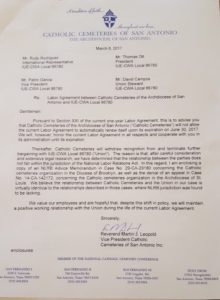Working Catholic
by Bill Droel
Death is the penalty we pay for Eve and Adam’s disobedience. How do we know? Because that is what our religion teacher said. Also, it is mentioned now and then in sermons. It is, however, fake news. Take a look at Genesis 3:4. Who explains things to Eve? It is the Prince of Lies who links mortality with Eden’s special fruit tree. In Genesis 2:18 God names a relationship between the fruit tree and death, but God never promises immortality to the residents of Paradise/Eden. This whole business about the fruit tree, by the way, is something Eve heard about second-hand.
Well then, work is the penalty for Eve and Adam’s disobedience. Again, fake news. Look at Genesis 2:15. Adam is already working, even before the snake incident. And after that episode, in Genesis 3:21, God too is working; this time as a clothier.
Admittedly there is a strong note in Catholic tradition that regards work as a penance for original sin or maybe a necessary evil or possibly a negative prod to make people pray and obey. During the Middle Ages some monks gave work a positive spin, but only as a backdrop to contemplation and other prayer. And Martin Luther (1483-1546) certainly knocked against the idea that ordinary work is beneath those so-called higher-ups, those round-the-clock spiritual types. Yet with some exceptions, work was not regarded as integral to the spiritual life, at least until recent times.
Not to overlook the French worker-priest movement and the writing of Fr. Marie Dominique Chenu, OP (1895-1990), it can be said that a decisive turn toward a Catholic theology of work took place in Poland. It was Cardinal Stefan Wyszynski (1901-1981) who heaved aside erroneous interpretations of Genesis. “God set Adam and Eve down in paradise and commanded them to dress it and to keep it,” he writes in a pastoral 1946 book, Duch Pracy Ludzkiej. “Work is therefore the duty of people from the first day of life. It is not the result of original sin. It is not a punishment for disobedience.”
In hundreds of talks and sermons, in poems and in his writings, most thoroughly in his 1981 On Human Work, Saint John Paul II (1920-2005) develops “a spirituality of work” which he considers normative; its basics “should be a heritage shared by all.” It is through work, John Paul II says, that we are co-creators with God, participating in God’s plan for a renewed world, a new Eden. Further, says John Paul II, our work is participation in Christ’s on-going redemption. This elevation of human work is not heresy, unless you are willing to say that our faithfully departed pontiff is a fake saint.
Just at a time a theology of work enters the Catholic mainstream, some people are echoing the Prince of Lies: Work only brings death. Today, asserts James Livingston in No More Work (University of North Carolina Press, 2016), “most of our labor has…little, diminishing or no value in the labor market.” Work does not contribute to “self-respect, self-discovery and social mobility,” Livingston continues. So, knock off the romanticism, take off the rosy glasses, and put away any spiritual spin. “Work means economic impoverishment not moral possibility.”
Well yes, romanticism has to go. After their disobedience Adam and Eve were told that work is entangled with toil. The Pharaoh’s hardness of heart caused work to be miserable for his slaves. So too, disregard for the innate dignity of each worker infects some companies today. Those formerly enslaved in Egypt wandered in a desert without meaning. They lost their solidarity; their connections. So too, many workers now ask: “Is God is in our midst or not?”
Yet work, with all the blemishes of sin, is good and in itself capable of contributing to the spiritual life. Thanks to some well-grounded thinkers, a Catholic theology has been sketched. It remains for more theologians in dialogue with loads of workers (executives, janitors, lab technicians, civic leaders, retail clerks, food processors, homemakers, solar panel installers, computer scientists, engineers, students and more) to flesh out a full pastoral theology that pertains to what 99% of Catholics do most of the time. Without a theology for and by workers, Christianity—hate to say it—is more fake news.
Droel is the editor of John Paul II’s Gospel of Work (National Center for the Laity, PO Box 291102, Chicago, IL 60629; $5)

